Evaluating Xtra Bank's Employee Orientation Program
VerifiedAdded on 2023/06/05
|9
|3709
|192
Essay
AI Summary
This essay analyzes Xtra Bank's employee orientation program, focusing on its history, vision, product knowledge, and customer service strategies. It examines how the bank aims to integrate new hires, emphasizing the importance of product knowledge for effective customer service and the adoption of a blended learning approach to accommodate diverse learning styles. The essay also explores the bank's commitment to inclusive learning, highlighting the significance of continuous improvement, cultural integration, and development and career planning within the organization. Furthermore, the essay underscores the benefits of face-to-face training and the role of orientation and training in fostering employee retention, commitment, and customer satisfaction. The bank aims to enhance its customer service, improve employee performance, and achieve its business objectives through these initiatives.
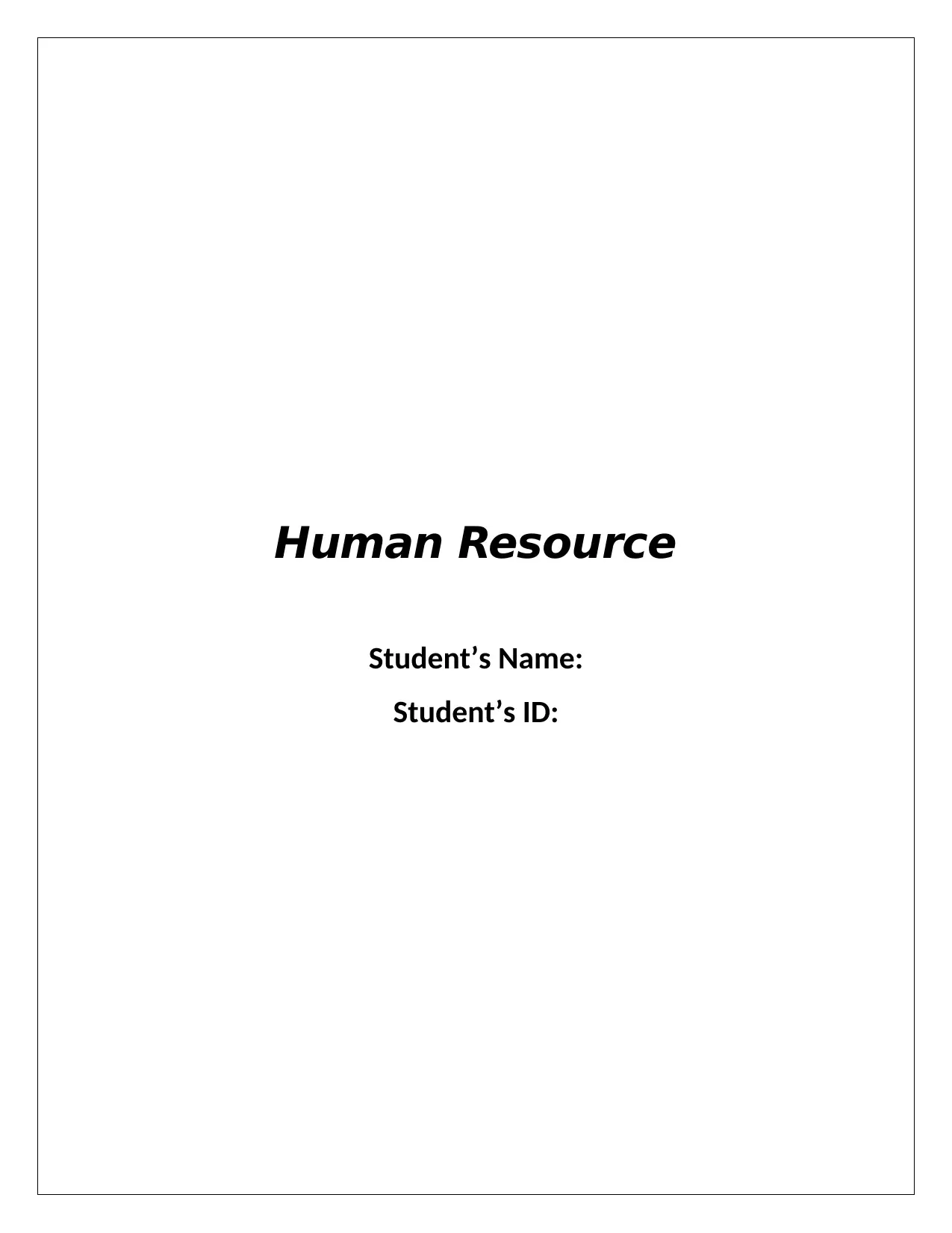
Human Resource
Student’s Name:
Student’s ID:
Student’s Name:
Student’s ID:
Paraphrase This Document
Need a fresh take? Get an instant paraphrase of this document with our AI Paraphraser
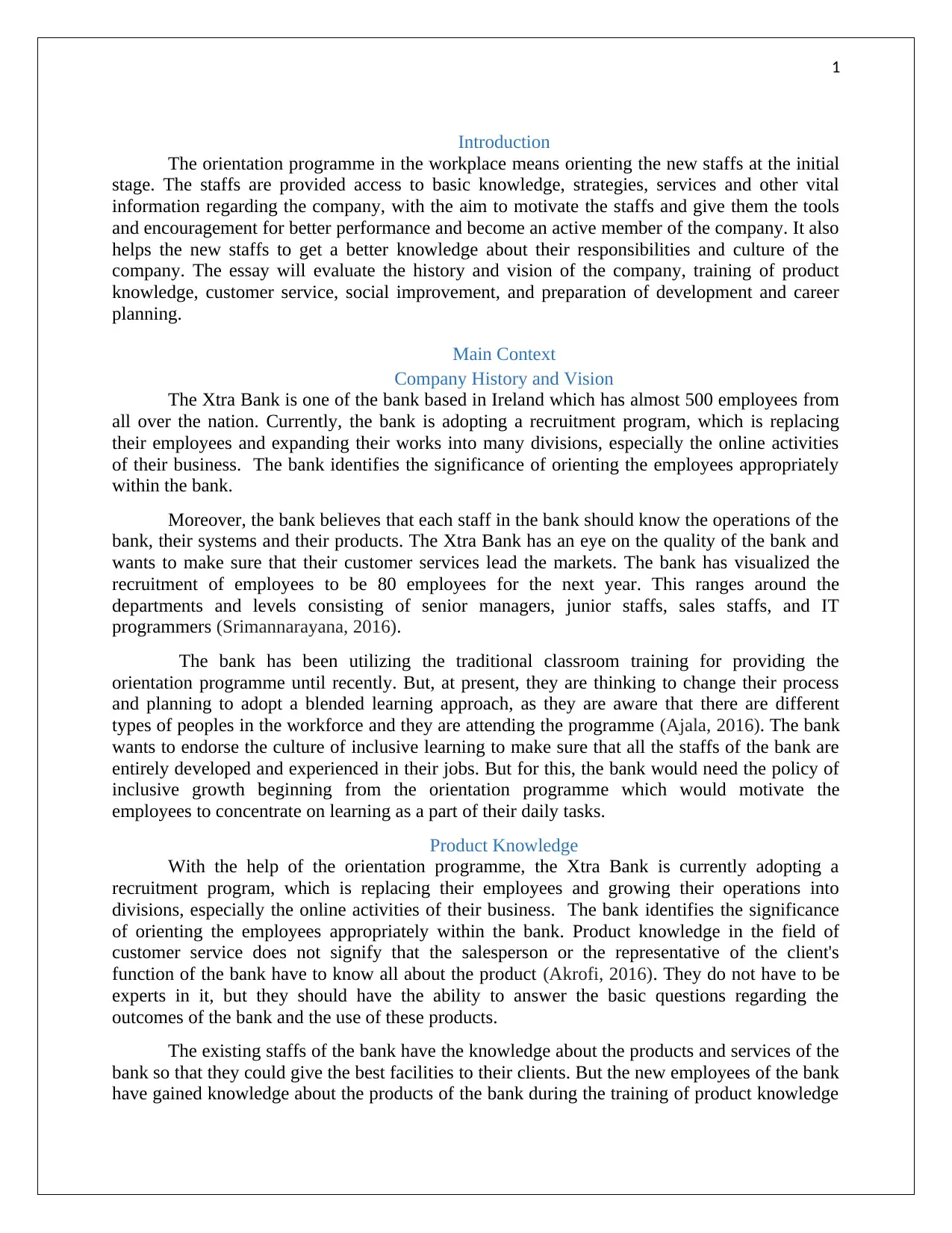
1
Introduction
The orientation programme in the workplace means orienting the new staffs at the initial
stage. The staffs are provided access to basic knowledge, strategies, services and other vital
information regarding the company, with the aim to motivate the staffs and give them the tools
and encouragement for better performance and become an active member of the company. It also
helps the new staffs to get a better knowledge about their responsibilities and culture of the
company. The essay will evaluate the history and vision of the company, training of product
knowledge, customer service, social improvement, and preparation of development and career
planning.
Main Context
Company History and Vision
The Xtra Bank is one of the bank based in Ireland which has almost 500 employees from
all over the nation. Currently, the bank is adopting a recruitment program, which is replacing
their employees and expanding their works into many divisions, especially the online activities
of their business. The bank identifies the significance of orienting the employees appropriately
within the bank.
Moreover, the bank believes that each staff in the bank should know the operations of the
bank, their systems and their products. The Xtra Bank has an eye on the quality of the bank and
wants to make sure that their customer services lead the markets. The bank has visualized the
recruitment of employees to be 80 employees for the next year. This ranges around the
departments and levels consisting of senior managers, junior staffs, sales staffs, and IT
programmers (Srimannarayana, 2016).
The bank has been utilizing the traditional classroom training for providing the
orientation programme until recently. But, at present, they are thinking to change their process
and planning to adopt a blended learning approach, as they are aware that there are different
types of peoples in the workforce and they are attending the programme (Ajala, 2016). The bank
wants to endorse the culture of inclusive learning to make sure that all the staffs of the bank are
entirely developed and experienced in their jobs. But for this, the bank would need the policy of
inclusive growth beginning from the orientation programme which would motivate the
employees to concentrate on learning as a part of their daily tasks.
Product Knowledge
With the help of the orientation programme, the Xtra Bank is currently adopting a
recruitment program, which is replacing their employees and growing their operations into
divisions, especially the online activities of their business. The bank identifies the significance
of orienting the employees appropriately within the bank. Product knowledge in the field of
customer service does not signify that the salesperson or the representative of the client's
function of the bank have to know all about the product (Akrofi, 2016). They do not have to be
experts in it, but they should have the ability to answer the basic questions regarding the
outcomes of the bank and the use of these products.
The existing staffs of the bank have the knowledge about the products and services of the
bank so that they could give the best facilities to their clients. But the new employees of the bank
have gained knowledge about the products of the bank during the training of product knowledge
Introduction
The orientation programme in the workplace means orienting the new staffs at the initial
stage. The staffs are provided access to basic knowledge, strategies, services and other vital
information regarding the company, with the aim to motivate the staffs and give them the tools
and encouragement for better performance and become an active member of the company. It also
helps the new staffs to get a better knowledge about their responsibilities and culture of the
company. The essay will evaluate the history and vision of the company, training of product
knowledge, customer service, social improvement, and preparation of development and career
planning.
Main Context
Company History and Vision
The Xtra Bank is one of the bank based in Ireland which has almost 500 employees from
all over the nation. Currently, the bank is adopting a recruitment program, which is replacing
their employees and expanding their works into many divisions, especially the online activities
of their business. The bank identifies the significance of orienting the employees appropriately
within the bank.
Moreover, the bank believes that each staff in the bank should know the operations of the
bank, their systems and their products. The Xtra Bank has an eye on the quality of the bank and
wants to make sure that their customer services lead the markets. The bank has visualized the
recruitment of employees to be 80 employees for the next year. This ranges around the
departments and levels consisting of senior managers, junior staffs, sales staffs, and IT
programmers (Srimannarayana, 2016).
The bank has been utilizing the traditional classroom training for providing the
orientation programme until recently. But, at present, they are thinking to change their process
and planning to adopt a blended learning approach, as they are aware that there are different
types of peoples in the workforce and they are attending the programme (Ajala, 2016). The bank
wants to endorse the culture of inclusive learning to make sure that all the staffs of the bank are
entirely developed and experienced in their jobs. But for this, the bank would need the policy of
inclusive growth beginning from the orientation programme which would motivate the
employees to concentrate on learning as a part of their daily tasks.
Product Knowledge
With the help of the orientation programme, the Xtra Bank is currently adopting a
recruitment program, which is replacing their employees and growing their operations into
divisions, especially the online activities of their business. The bank identifies the significance
of orienting the employees appropriately within the bank. Product knowledge in the field of
customer service does not signify that the salesperson or the representative of the client's
function of the bank have to know all about the product (Akrofi, 2016). They do not have to be
experts in it, but they should have the ability to answer the basic questions regarding the
outcomes of the bank and the use of these products.
The existing staffs of the bank have the knowledge about the products and services of the
bank so that they could give the best facilities to their clients. But the new employees of the bank
have gained knowledge about the products of the bank during the training of product knowledge
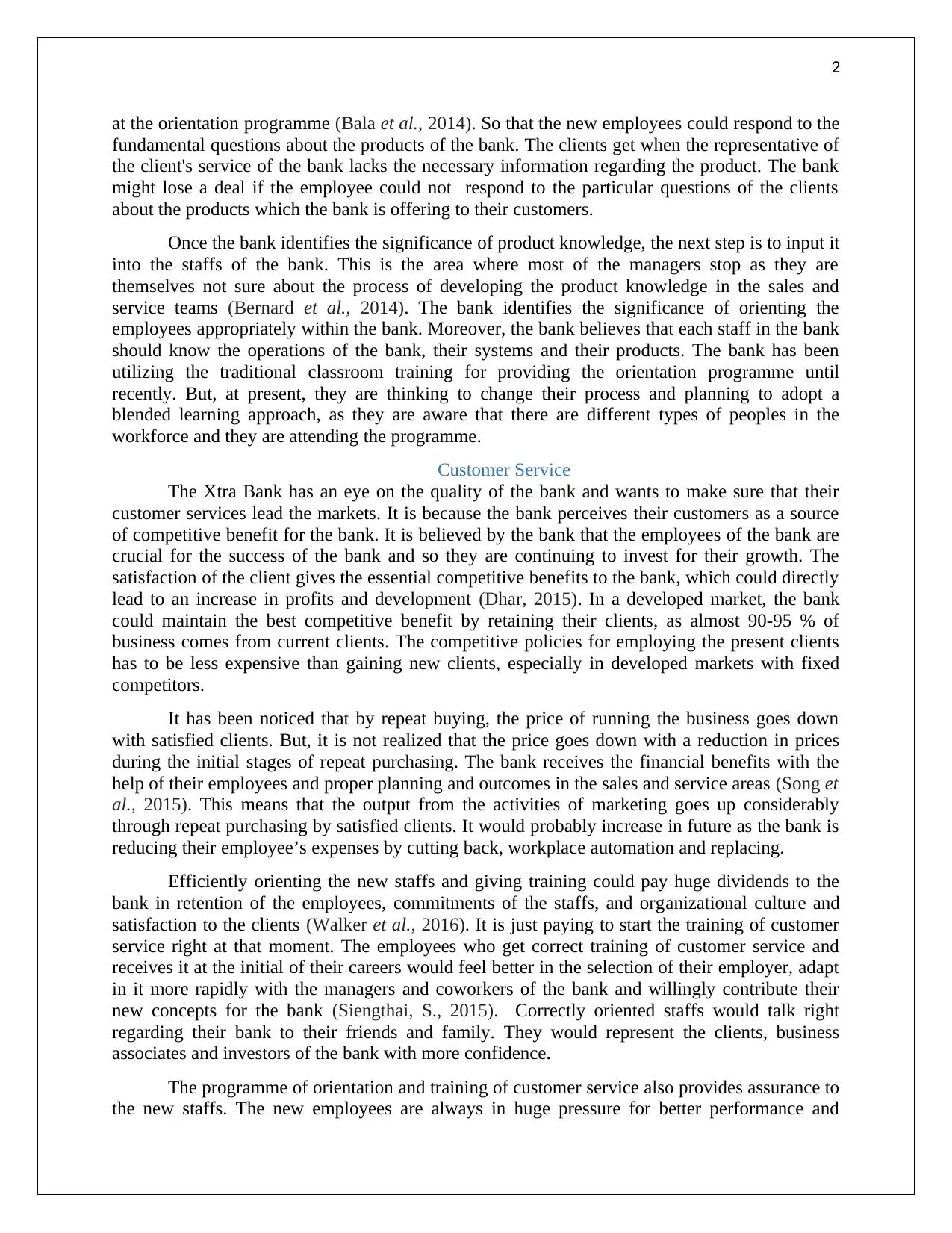
2
at the orientation programme (Bala et al., 2014). So that the new employees could respond to the
fundamental questions about the products of the bank. The clients get when the representative of
the client's service of the bank lacks the necessary information regarding the product. The bank
might lose a deal if the employee could not respond to the particular questions of the clients
about the products which the bank is offering to their customers.
Once the bank identifies the significance of product knowledge, the next step is to input it
into the staffs of the bank. This is the area where most of the managers stop as they are
themselves not sure about the process of developing the product knowledge in the sales and
service teams (Bernard et al., 2014). The bank identifies the significance of orienting the
employees appropriately within the bank. Moreover, the bank believes that each staff in the bank
should know the operations of the bank, their systems and their products. The bank has been
utilizing the traditional classroom training for providing the orientation programme until
recently. But, at present, they are thinking to change their process and planning to adopt a
blended learning approach, as they are aware that there are different types of peoples in the
workforce and they are attending the programme.
Customer Service
The Xtra Bank has an eye on the quality of the bank and wants to make sure that their
customer services lead the markets. It is because the bank perceives their customers as a source
of competitive benefit for the bank. It is believed by the bank that the employees of the bank are
crucial for the success of the bank and so they are continuing to invest for their growth. The
satisfaction of the client gives the essential competitive benefits to the bank, which could directly
lead to an increase in profits and development (Dhar, 2015). In a developed market, the bank
could maintain the best competitive benefit by retaining their clients, as almost 90-95 % of
business comes from current clients. The competitive policies for employing the present clients
has to be less expensive than gaining new clients, especially in developed markets with fixed
competitors.
It has been noticed that by repeat buying, the price of running the business goes down
with satisfied clients. But, it is not realized that the price goes down with a reduction in prices
during the initial stages of repeat purchasing. The bank receives the financial benefits with the
help of their employees and proper planning and outcomes in the sales and service areas (Song et
al., 2015). This means that the output from the activities of marketing goes up considerably
through repeat purchasing by satisfied clients. It would probably increase in future as the bank is
reducing their employee’s expenses by cutting back, workplace automation and replacing.
Efficiently orienting the new staffs and giving training could pay huge dividends to the
bank in retention of the employees, commitments of the staffs, and organizational culture and
satisfaction to the clients (Walker et al., 2016). It is just paying to start the training of customer
service right at that moment. The employees who get correct training of customer service and
receives it at the initial of their careers would feel better in the selection of their employer, adapt
in it more rapidly with the managers and coworkers of the bank and willingly contribute their
new concepts for the bank (Siengthai, S., 2015). Correctly oriented staffs would talk right
regarding their bank to their friends and family. They would represent the clients, business
associates and investors of the bank with more confidence.
The programme of orientation and training of customer service also provides assurance to
the new staffs. The new employees are always in huge pressure for better performance and
at the orientation programme (Bala et al., 2014). So that the new employees could respond to the
fundamental questions about the products of the bank. The clients get when the representative of
the client's service of the bank lacks the necessary information regarding the product. The bank
might lose a deal if the employee could not respond to the particular questions of the clients
about the products which the bank is offering to their customers.
Once the bank identifies the significance of product knowledge, the next step is to input it
into the staffs of the bank. This is the area where most of the managers stop as they are
themselves not sure about the process of developing the product knowledge in the sales and
service teams (Bernard et al., 2014). The bank identifies the significance of orienting the
employees appropriately within the bank. Moreover, the bank believes that each staff in the bank
should know the operations of the bank, their systems and their products. The bank has been
utilizing the traditional classroom training for providing the orientation programme until
recently. But, at present, they are thinking to change their process and planning to adopt a
blended learning approach, as they are aware that there are different types of peoples in the
workforce and they are attending the programme.
Customer Service
The Xtra Bank has an eye on the quality of the bank and wants to make sure that their
customer services lead the markets. It is because the bank perceives their customers as a source
of competitive benefit for the bank. It is believed by the bank that the employees of the bank are
crucial for the success of the bank and so they are continuing to invest for their growth. The
satisfaction of the client gives the essential competitive benefits to the bank, which could directly
lead to an increase in profits and development (Dhar, 2015). In a developed market, the bank
could maintain the best competitive benefit by retaining their clients, as almost 90-95 % of
business comes from current clients. The competitive policies for employing the present clients
has to be less expensive than gaining new clients, especially in developed markets with fixed
competitors.
It has been noticed that by repeat buying, the price of running the business goes down
with satisfied clients. But, it is not realized that the price goes down with a reduction in prices
during the initial stages of repeat purchasing. The bank receives the financial benefits with the
help of their employees and proper planning and outcomes in the sales and service areas (Song et
al., 2015). This means that the output from the activities of marketing goes up considerably
through repeat purchasing by satisfied clients. It would probably increase in future as the bank is
reducing their employee’s expenses by cutting back, workplace automation and replacing.
Efficiently orienting the new staffs and giving training could pay huge dividends to the
bank in retention of the employees, commitments of the staffs, and organizational culture and
satisfaction to the clients (Walker et al., 2016). It is just paying to start the training of customer
service right at that moment. The employees who get correct training of customer service and
receives it at the initial of their careers would feel better in the selection of their employer, adapt
in it more rapidly with the managers and coworkers of the bank and willingly contribute their
new concepts for the bank (Siengthai, S., 2015). Correctly oriented staffs would talk right
regarding their bank to their friends and family. They would represent the clients, business
associates and investors of the bank with more confidence.
The programme of orientation and training of customer service also provides assurance to
the new staffs. The new employees are always in huge pressure for better performance and
⊘ This is a preview!⊘
Do you want full access?
Subscribe today to unlock all pages.

Trusted by 1+ million students worldwide
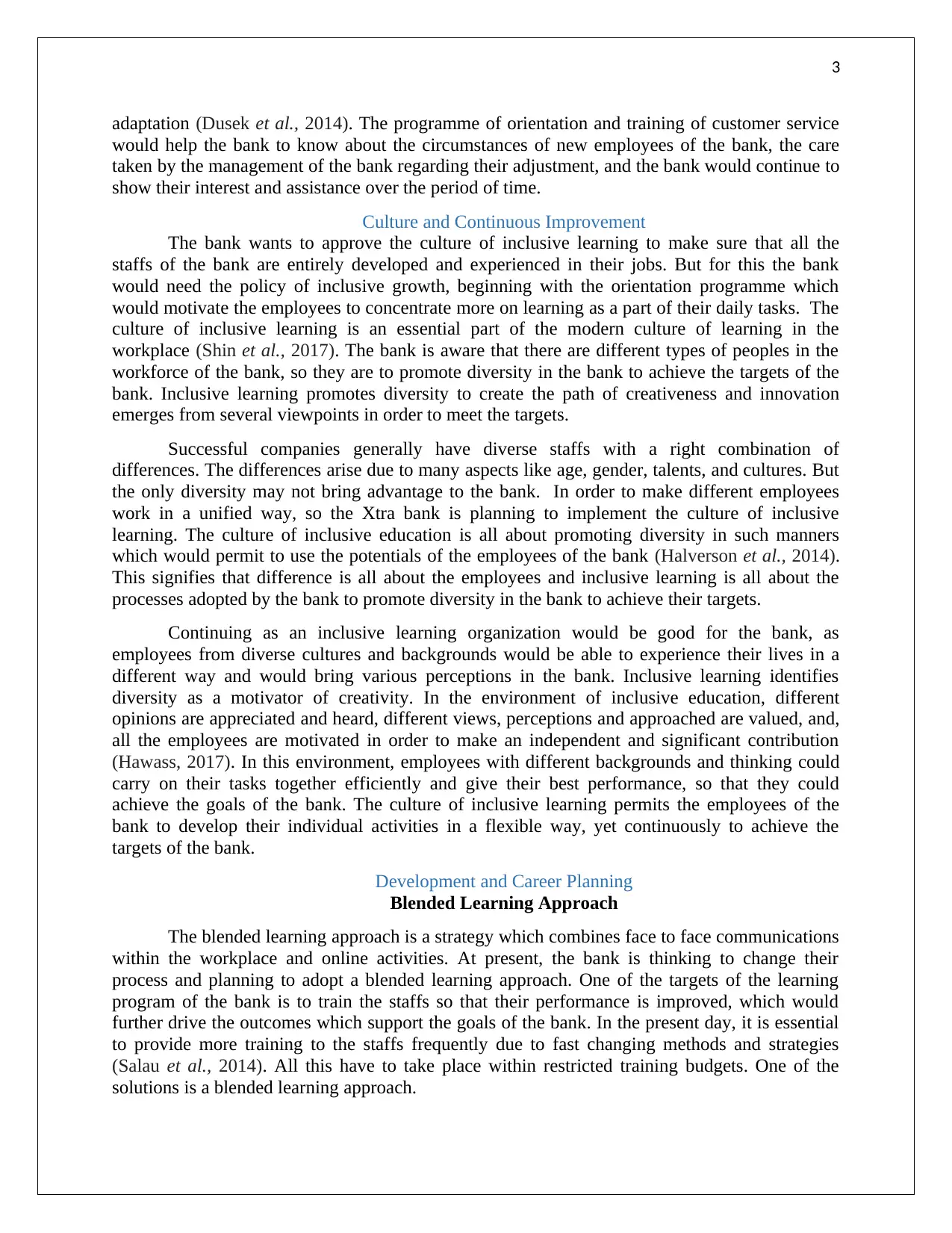
3
adaptation (Dusek et al., 2014). The programme of orientation and training of customer service
would help the bank to know about the circumstances of new employees of the bank, the care
taken by the management of the bank regarding their adjustment, and the bank would continue to
show their interest and assistance over the period of time.
Culture and Continuous Improvement
The bank wants to approve the culture of inclusive learning to make sure that all the
staffs of the bank are entirely developed and experienced in their jobs. But for this the bank
would need the policy of inclusive growth, beginning with the orientation programme which
would motivate the employees to concentrate more on learning as a part of their daily tasks. The
culture of inclusive learning is an essential part of the modern culture of learning in the
workplace (Shin et al., 2017). The bank is aware that there are different types of peoples in the
workforce of the bank, so they are to promote diversity in the bank to achieve the targets of the
bank. Inclusive learning promotes diversity to create the path of creativeness and innovation
emerges from several viewpoints in order to meet the targets.
Successful companies generally have diverse staffs with a right combination of
differences. The differences arise due to many aspects like age, gender, talents, and cultures. But
the only diversity may not bring advantage to the bank. In order to make different employees
work in a unified way, so the Xtra bank is planning to implement the culture of inclusive
learning. The culture of inclusive education is all about promoting diversity in such manners
which would permit to use the potentials of the employees of the bank (Halverson et al., 2014).
This signifies that difference is all about the employees and inclusive learning is all about the
processes adopted by the bank to promote diversity in the bank to achieve their targets.
Continuing as an inclusive learning organization would be good for the bank, as
employees from diverse cultures and backgrounds would be able to experience their lives in a
different way and would bring various perceptions in the bank. Inclusive learning identifies
diversity as a motivator of creativity. In the environment of inclusive education, different
opinions are appreciated and heard, different views, perceptions and approached are valued, and,
all the employees are motivated in order to make an independent and significant contribution
(Hawass, 2017). In this environment, employees with different backgrounds and thinking could
carry on their tasks together efficiently and give their best performance, so that they could
achieve the goals of the bank. The culture of inclusive learning permits the employees of the
bank to develop their individual activities in a flexible way, yet continuously to achieve the
targets of the bank.
Development and Career Planning
Blended Learning Approach
The blended learning approach is a strategy which combines face to face communications
within the workplace and online activities. At present, the bank is thinking to change their
process and planning to adopt a blended learning approach. One of the targets of the learning
program of the bank is to train the staffs so that their performance is improved, which would
further drive the outcomes which support the goals of the bank. In the present day, it is essential
to provide more training to the staffs frequently due to fast changing methods and strategies
(Salau et al., 2014). All this have to take place within restricted training budgets. One of the
solutions is a blended learning approach.
adaptation (Dusek et al., 2014). The programme of orientation and training of customer service
would help the bank to know about the circumstances of new employees of the bank, the care
taken by the management of the bank regarding their adjustment, and the bank would continue to
show their interest and assistance over the period of time.
Culture and Continuous Improvement
The bank wants to approve the culture of inclusive learning to make sure that all the
staffs of the bank are entirely developed and experienced in their jobs. But for this the bank
would need the policy of inclusive growth, beginning with the orientation programme which
would motivate the employees to concentrate more on learning as a part of their daily tasks. The
culture of inclusive learning is an essential part of the modern culture of learning in the
workplace (Shin et al., 2017). The bank is aware that there are different types of peoples in the
workforce of the bank, so they are to promote diversity in the bank to achieve the targets of the
bank. Inclusive learning promotes diversity to create the path of creativeness and innovation
emerges from several viewpoints in order to meet the targets.
Successful companies generally have diverse staffs with a right combination of
differences. The differences arise due to many aspects like age, gender, talents, and cultures. But
the only diversity may not bring advantage to the bank. In order to make different employees
work in a unified way, so the Xtra bank is planning to implement the culture of inclusive
learning. The culture of inclusive education is all about promoting diversity in such manners
which would permit to use the potentials of the employees of the bank (Halverson et al., 2014).
This signifies that difference is all about the employees and inclusive learning is all about the
processes adopted by the bank to promote diversity in the bank to achieve their targets.
Continuing as an inclusive learning organization would be good for the bank, as
employees from diverse cultures and backgrounds would be able to experience their lives in a
different way and would bring various perceptions in the bank. Inclusive learning identifies
diversity as a motivator of creativity. In the environment of inclusive education, different
opinions are appreciated and heard, different views, perceptions and approached are valued, and,
all the employees are motivated in order to make an independent and significant contribution
(Hawass, 2017). In this environment, employees with different backgrounds and thinking could
carry on their tasks together efficiently and give their best performance, so that they could
achieve the goals of the bank. The culture of inclusive learning permits the employees of the
bank to develop their individual activities in a flexible way, yet continuously to achieve the
targets of the bank.
Development and Career Planning
Blended Learning Approach
The blended learning approach is a strategy which combines face to face communications
within the workplace and online activities. At present, the bank is thinking to change their
process and planning to adopt a blended learning approach. One of the targets of the learning
program of the bank is to train the staffs so that their performance is improved, which would
further drive the outcomes which support the goals of the bank. In the present day, it is essential
to provide more training to the staffs frequently due to fast changing methods and strategies
(Salau et al., 2014). All this have to take place within restricted training budgets. One of the
solutions is a blended learning approach.
Paraphrase This Document
Need a fresh take? Get an instant paraphrase of this document with our AI Paraphraser
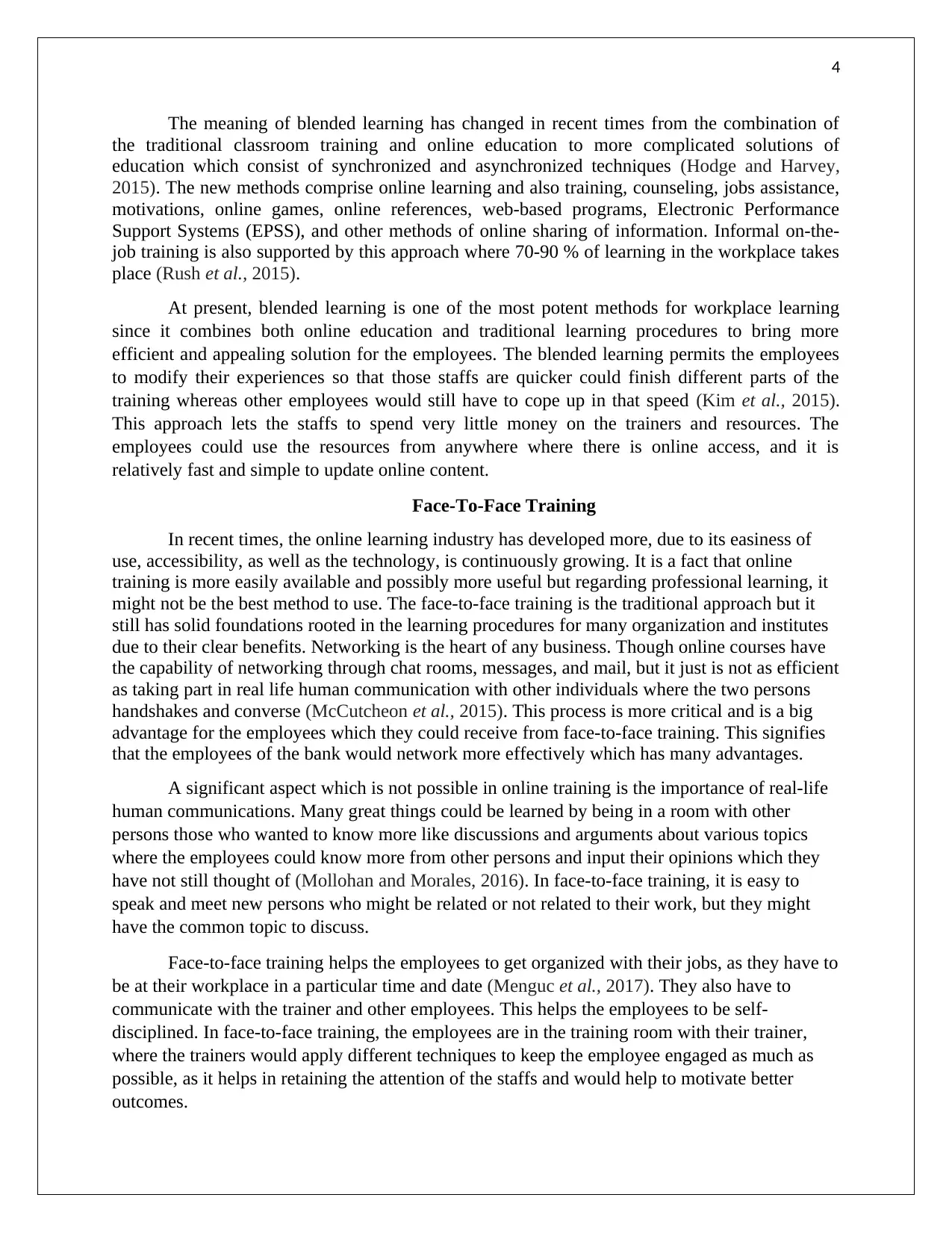
4
The meaning of blended learning has changed in recent times from the combination of
the traditional classroom training and online education to more complicated solutions of
education which consist of synchronized and asynchronized techniques (Hodge and Harvey,
2015). The new methods comprise online learning and also training, counseling, jobs assistance,
motivations, online games, online references, web-based programs, Electronic Performance
Support Systems (EPSS), and other methods of online sharing of information. Informal on-the-
job training is also supported by this approach where 70-90 % of learning in the workplace takes
place (Rush et al., 2015).
At present, blended learning is one of the most potent methods for workplace learning
since it combines both online education and traditional learning procedures to bring more
efficient and appealing solution for the employees. The blended learning permits the employees
to modify their experiences so that those staffs are quicker could finish different parts of the
training whereas other employees would still have to cope up in that speed (Kim et al., 2015).
This approach lets the staffs to spend very little money on the trainers and resources. The
employees could use the resources from anywhere where there is online access, and it is
relatively fast and simple to update online content.
Face-To-Face Training
In recent times, the online learning industry has developed more, due to its easiness of
use, accessibility, as well as the technology, is continuously growing. It is a fact that online
training is more easily available and possibly more useful but regarding professional learning, it
might not be the best method to use. The face-to-face training is the traditional approach but it
still has solid foundations rooted in the learning procedures for many organization and institutes
due to their clear benefits. Networking is the heart of any business. Though online courses have
the capability of networking through chat rooms, messages, and mail, but it just is not as efficient
as taking part in real life human communication with other individuals where the two persons
handshakes and converse (McCutcheon et al., 2015). This process is more critical and is a big
advantage for the employees which they could receive from face-to-face training. This signifies
that the employees of the bank would network more effectively which has many advantages.
A significant aspect which is not possible in online training is the importance of real-life
human communications. Many great things could be learned by being in a room with other
persons those who wanted to know more like discussions and arguments about various topics
where the employees could know more from other persons and input their opinions which they
have not still thought of (Mollohan and Morales, 2016). In face-to-face training, it is easy to
speak and meet new persons who might be related or not related to their work, but they might
have the common topic to discuss.
Face-to-face training helps the employees to get organized with their jobs, as they have to
be at their workplace in a particular time and date (Menguc et al., 2017). They also have to
communicate with the trainer and other employees. This helps the employees to be self-
disciplined. In face-to-face training, the employees are in the training room with their trainer,
where the trainers would apply different techniques to keep the employee engaged as much as
possible, as it helps in retaining the attention of the staffs and would help to motivate better
outcomes.
The meaning of blended learning has changed in recent times from the combination of
the traditional classroom training and online education to more complicated solutions of
education which consist of synchronized and asynchronized techniques (Hodge and Harvey,
2015). The new methods comprise online learning and also training, counseling, jobs assistance,
motivations, online games, online references, web-based programs, Electronic Performance
Support Systems (EPSS), and other methods of online sharing of information. Informal on-the-
job training is also supported by this approach where 70-90 % of learning in the workplace takes
place (Rush et al., 2015).
At present, blended learning is one of the most potent methods for workplace learning
since it combines both online education and traditional learning procedures to bring more
efficient and appealing solution for the employees. The blended learning permits the employees
to modify their experiences so that those staffs are quicker could finish different parts of the
training whereas other employees would still have to cope up in that speed (Kim et al., 2015).
This approach lets the staffs to spend very little money on the trainers and resources. The
employees could use the resources from anywhere where there is online access, and it is
relatively fast and simple to update online content.
Face-To-Face Training
In recent times, the online learning industry has developed more, due to its easiness of
use, accessibility, as well as the technology, is continuously growing. It is a fact that online
training is more easily available and possibly more useful but regarding professional learning, it
might not be the best method to use. The face-to-face training is the traditional approach but it
still has solid foundations rooted in the learning procedures for many organization and institutes
due to their clear benefits. Networking is the heart of any business. Though online courses have
the capability of networking through chat rooms, messages, and mail, but it just is not as efficient
as taking part in real life human communication with other individuals where the two persons
handshakes and converse (McCutcheon et al., 2015). This process is more critical and is a big
advantage for the employees which they could receive from face-to-face training. This signifies
that the employees of the bank would network more effectively which has many advantages.
A significant aspect which is not possible in online training is the importance of real-life
human communications. Many great things could be learned by being in a room with other
persons those who wanted to know more like discussions and arguments about various topics
where the employees could know more from other persons and input their opinions which they
have not still thought of (Mollohan and Morales, 2016). In face-to-face training, it is easy to
speak and meet new persons who might be related or not related to their work, but they might
have the common topic to discuss.
Face-to-face training helps the employees to get organized with their jobs, as they have to
be at their workplace in a particular time and date (Menguc et al., 2017). They also have to
communicate with the trainer and other employees. This helps the employees to be self-
disciplined. In face-to-face training, the employees are in the training room with their trainer,
where the trainers would apply different techniques to keep the employee engaged as much as
possible, as it helps in retaining the attention of the staffs and would help to motivate better
outcomes.
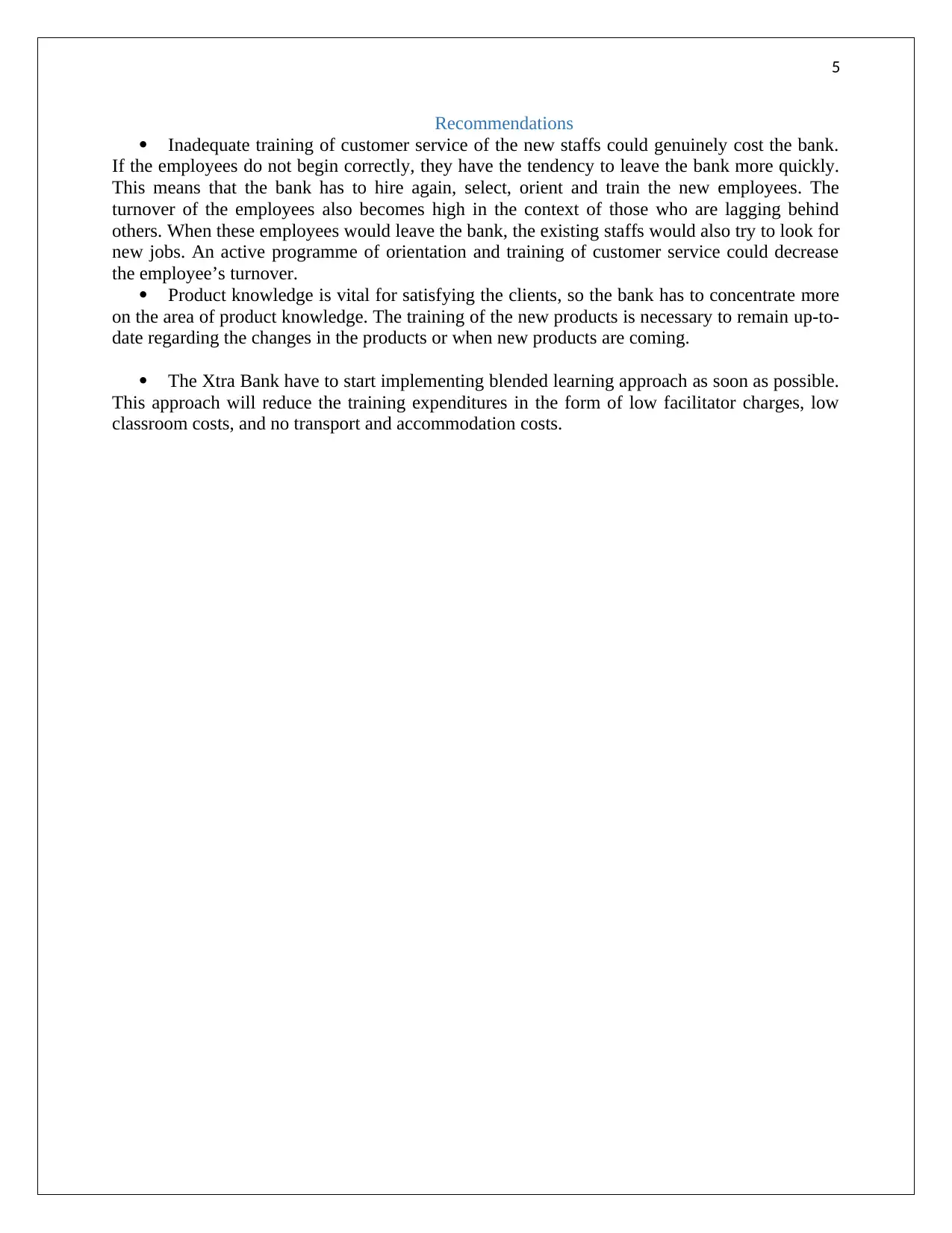
5
Recommendations
Inadequate training of customer service of the new staffs could genuinely cost the bank.
If the employees do not begin correctly, they have the tendency to leave the bank more quickly.
This means that the bank has to hire again, select, orient and train the new employees. The
turnover of the employees also becomes high in the context of those who are lagging behind
others. When these employees would leave the bank, the existing staffs would also try to look for
new jobs. An active programme of orientation and training of customer service could decrease
the employee’s turnover.
Product knowledge is vital for satisfying the clients, so the bank has to concentrate more
on the area of product knowledge. The training of the new products is necessary to remain up-to-
date regarding the changes in the products or when new products are coming.
The Xtra Bank have to start implementing blended learning approach as soon as possible.
This approach will reduce the training expenditures in the form of low facilitator charges, low
classroom costs, and no transport and accommodation costs.
Recommendations
Inadequate training of customer service of the new staffs could genuinely cost the bank.
If the employees do not begin correctly, they have the tendency to leave the bank more quickly.
This means that the bank has to hire again, select, orient and train the new employees. The
turnover of the employees also becomes high in the context of those who are lagging behind
others. When these employees would leave the bank, the existing staffs would also try to look for
new jobs. An active programme of orientation and training of customer service could decrease
the employee’s turnover.
Product knowledge is vital for satisfying the clients, so the bank has to concentrate more
on the area of product knowledge. The training of the new products is necessary to remain up-to-
date regarding the changes in the products or when new products are coming.
The Xtra Bank have to start implementing blended learning approach as soon as possible.
This approach will reduce the training expenditures in the form of low facilitator charges, low
classroom costs, and no transport and accommodation costs.
⊘ This is a preview!⊘
Do you want full access?
Subscribe today to unlock all pages.

Trusted by 1+ million students worldwide
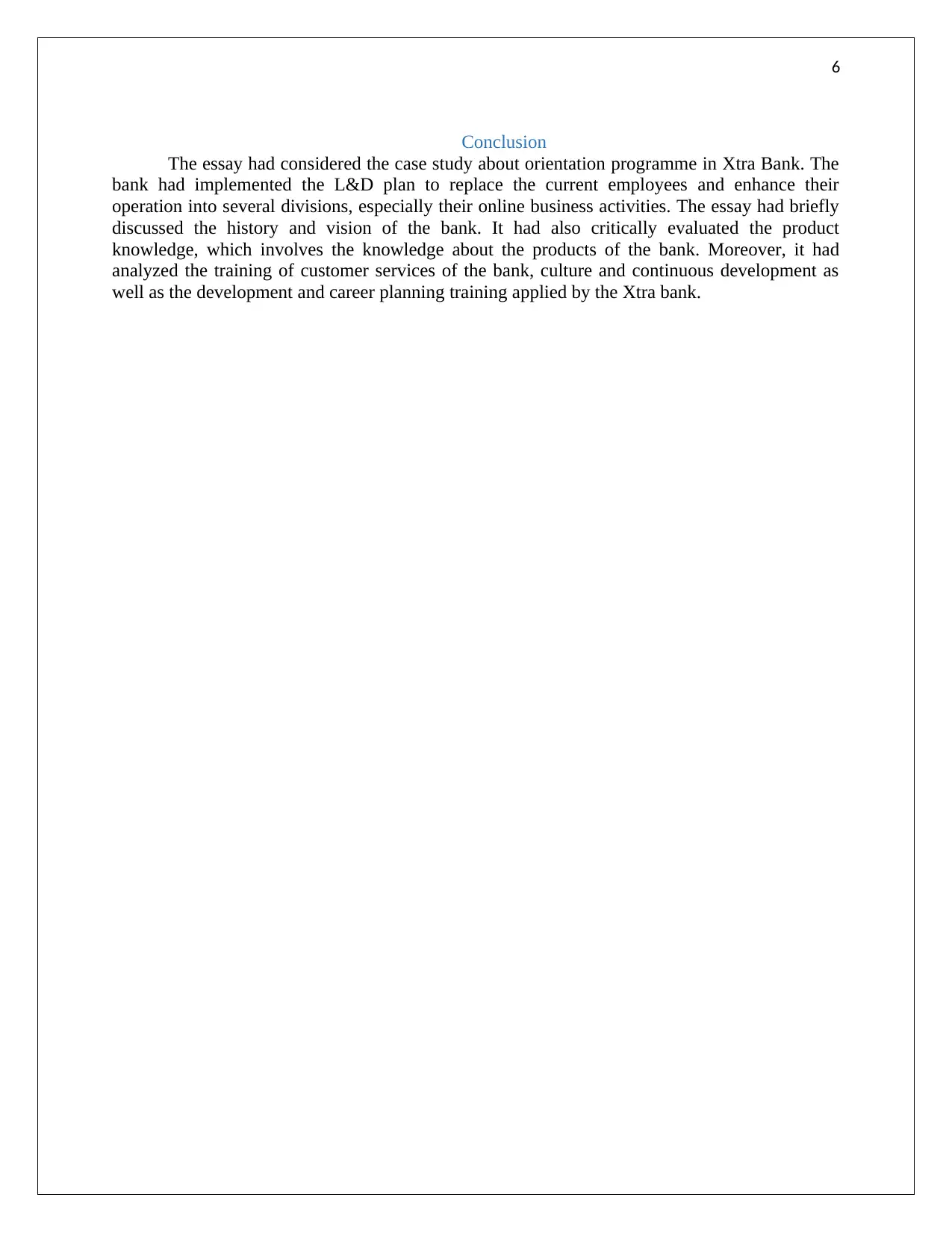
6
Conclusion
The essay had considered the case study about orientation programme in Xtra Bank. The
bank had implemented the L&D plan to replace the current employees and enhance their
operation into several divisions, especially their online business activities. The essay had briefly
discussed the history and vision of the bank. It had also critically evaluated the product
knowledge, which involves the knowledge about the products of the bank. Moreover, it had
analyzed the training of customer services of the bank, culture and continuous development as
well as the development and career planning training applied by the Xtra bank.
Conclusion
The essay had considered the case study about orientation programme in Xtra Bank. The
bank had implemented the L&D plan to replace the current employees and enhance their
operation into several divisions, especially their online business activities. The essay had briefly
discussed the history and vision of the bank. It had also critically evaluated the product
knowledge, which involves the knowledge about the products of the bank. Moreover, it had
analyzed the training of customer services of the bank, culture and continuous development as
well as the development and career planning training applied by the Xtra bank.
Paraphrase This Document
Need a fresh take? Get an instant paraphrase of this document with our AI Paraphraser
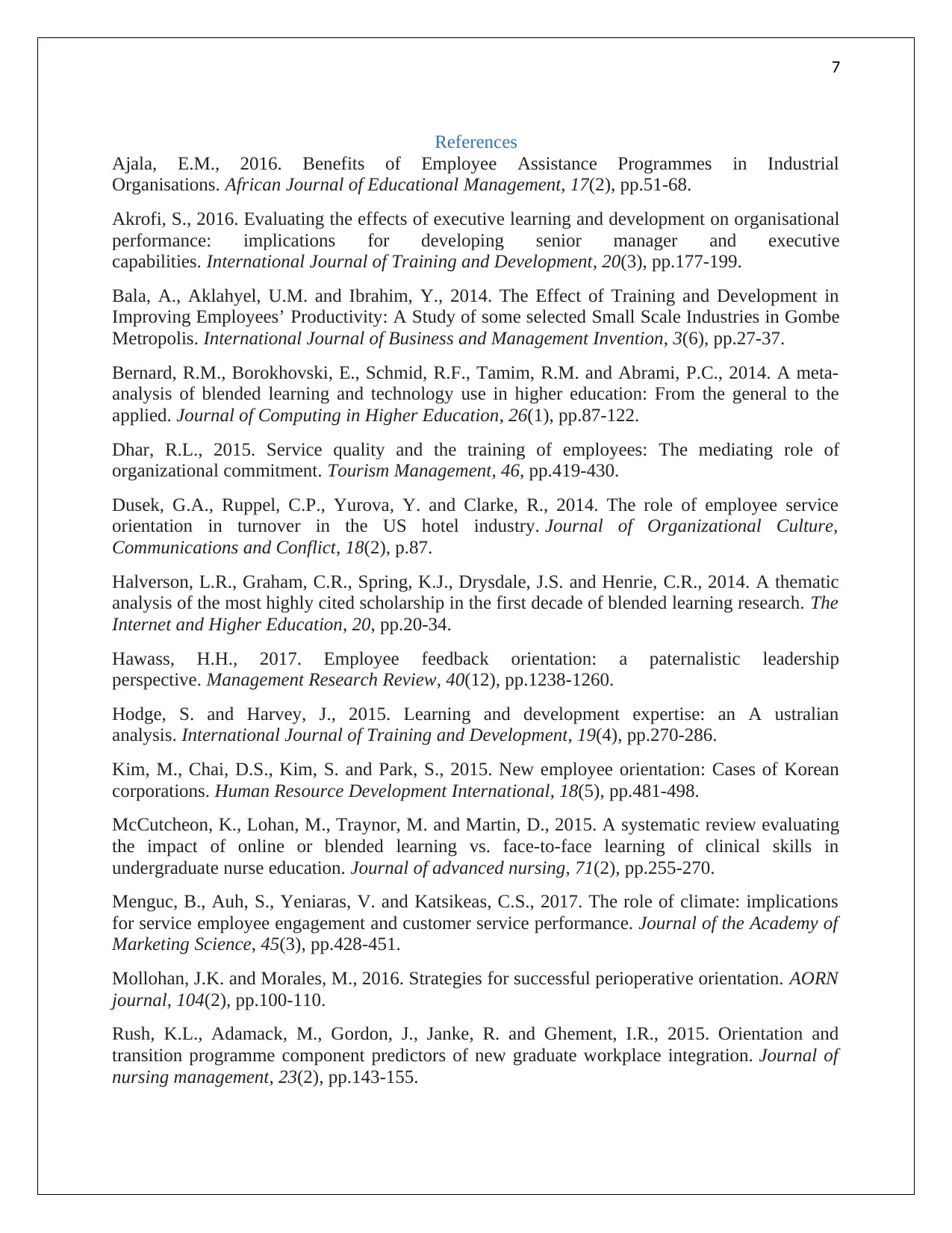
7
References
Ajala, E.M., 2016. Benefits of Employee Assistance Programmes in Industrial
Organisations. African Journal of Educational Management, 17(2), pp.51-68.
Akrofi, S., 2016. Evaluating the effects of executive learning and development on organisational
performance: implications for developing senior manager and executive
capabilities. International Journal of Training and Development, 20(3), pp.177-199.
Bala, A., Aklahyel, U.M. and Ibrahim, Y., 2014. The Effect of Training and Development in
Improving Employees’ Productivity: A Study of some selected Small Scale Industries in Gombe
Metropolis. International Journal of Business and Management Invention, 3(6), pp.27-37.
Bernard, R.M., Borokhovski, E., Schmid, R.F., Tamim, R.M. and Abrami, P.C., 2014. A meta-
analysis of blended learning and technology use in higher education: From the general to the
applied. Journal of Computing in Higher Education, 26(1), pp.87-122.
Dhar, R.L., 2015. Service quality and the training of employees: The mediating role of
organizational commitment. Tourism Management, 46, pp.419-430.
Dusek, G.A., Ruppel, C.P., Yurova, Y. and Clarke, R., 2014. The role of employee service
orientation in turnover in the US hotel industry. Journal of Organizational Culture,
Communications and Conflict, 18(2), p.87.
Halverson, L.R., Graham, C.R., Spring, K.J., Drysdale, J.S. and Henrie, C.R., 2014. A thematic
analysis of the most highly cited scholarship in the first decade of blended learning research. The
Internet and Higher Education, 20, pp.20-34.
Hawass, H.H., 2017. Employee feedback orientation: a paternalistic leadership
perspective. Management Research Review, 40(12), pp.1238-1260.
Hodge, S. and Harvey, J., 2015. Learning and development expertise: an A ustralian
analysis. International Journal of Training and Development, 19(4), pp.270-286.
Kim, M., Chai, D.S., Kim, S. and Park, S., 2015. New employee orientation: Cases of Korean
corporations. Human Resource Development International, 18(5), pp.481-498.
McCutcheon, K., Lohan, M., Traynor, M. and Martin, D., 2015. A systematic review evaluating
the impact of online or blended learning vs. face‐to‐face learning of clinical skills in
undergraduate nurse education. Journal of advanced nursing, 71(2), pp.255-270.
Menguc, B., Auh, S., Yeniaras, V. and Katsikeas, C.S., 2017. The role of climate: implications
for service employee engagement and customer service performance. Journal of the Academy of
Marketing Science, 45(3), pp.428-451.
Mollohan, J.K. and Morales, M., 2016. Strategies for successful perioperative orientation. AORN
journal, 104(2), pp.100-110.
Rush, K.L., Adamack, M., Gordon, J., Janke, R. and Ghement, I.R., 2015. Orientation and
transition programme component predictors of new graduate workplace integration. Journal of
nursing management, 23(2), pp.143-155.
References
Ajala, E.M., 2016. Benefits of Employee Assistance Programmes in Industrial
Organisations. African Journal of Educational Management, 17(2), pp.51-68.
Akrofi, S., 2016. Evaluating the effects of executive learning and development on organisational
performance: implications for developing senior manager and executive
capabilities. International Journal of Training and Development, 20(3), pp.177-199.
Bala, A., Aklahyel, U.M. and Ibrahim, Y., 2014. The Effect of Training and Development in
Improving Employees’ Productivity: A Study of some selected Small Scale Industries in Gombe
Metropolis. International Journal of Business and Management Invention, 3(6), pp.27-37.
Bernard, R.M., Borokhovski, E., Schmid, R.F., Tamim, R.M. and Abrami, P.C., 2014. A meta-
analysis of blended learning and technology use in higher education: From the general to the
applied. Journal of Computing in Higher Education, 26(1), pp.87-122.
Dhar, R.L., 2015. Service quality and the training of employees: The mediating role of
organizational commitment. Tourism Management, 46, pp.419-430.
Dusek, G.A., Ruppel, C.P., Yurova, Y. and Clarke, R., 2014. The role of employee service
orientation in turnover in the US hotel industry. Journal of Organizational Culture,
Communications and Conflict, 18(2), p.87.
Halverson, L.R., Graham, C.R., Spring, K.J., Drysdale, J.S. and Henrie, C.R., 2014. A thematic
analysis of the most highly cited scholarship in the first decade of blended learning research. The
Internet and Higher Education, 20, pp.20-34.
Hawass, H.H., 2017. Employee feedback orientation: a paternalistic leadership
perspective. Management Research Review, 40(12), pp.1238-1260.
Hodge, S. and Harvey, J., 2015. Learning and development expertise: an A ustralian
analysis. International Journal of Training and Development, 19(4), pp.270-286.
Kim, M., Chai, D.S., Kim, S. and Park, S., 2015. New employee orientation: Cases of Korean
corporations. Human Resource Development International, 18(5), pp.481-498.
McCutcheon, K., Lohan, M., Traynor, M. and Martin, D., 2015. A systematic review evaluating
the impact of online or blended learning vs. face‐to‐face learning of clinical skills in
undergraduate nurse education. Journal of advanced nursing, 71(2), pp.255-270.
Menguc, B., Auh, S., Yeniaras, V. and Katsikeas, C.S., 2017. The role of climate: implications
for service employee engagement and customer service performance. Journal of the Academy of
Marketing Science, 45(3), pp.428-451.
Mollohan, J.K. and Morales, M., 2016. Strategies for successful perioperative orientation. AORN
journal, 104(2), pp.100-110.
Rush, K.L., Adamack, M., Gordon, J., Janke, R. and Ghement, I.R., 2015. Orientation and
transition programme component predictors of new graduate workplace integration. Journal of
nursing management, 23(2), pp.143-155.
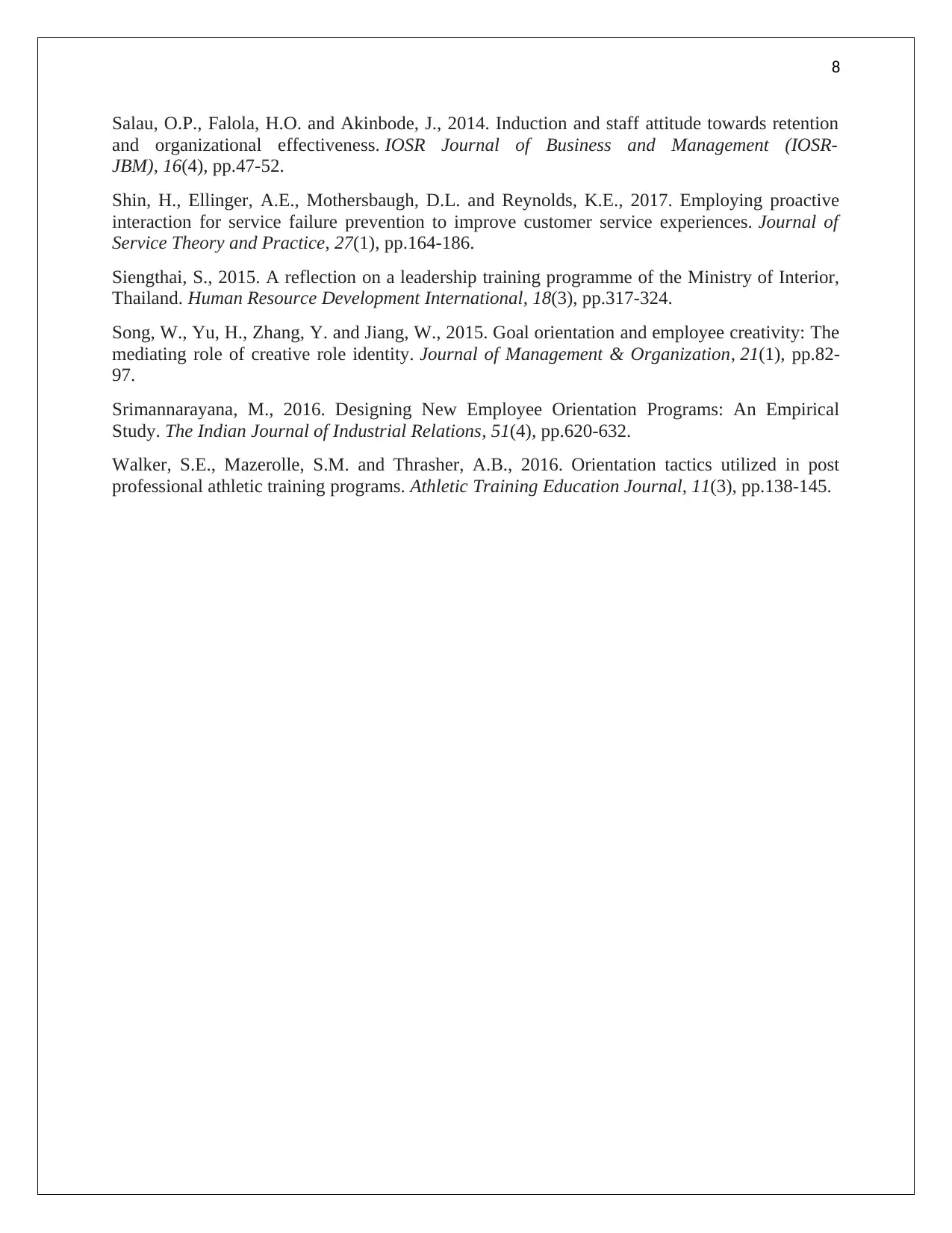
8
Salau, O.P., Falola, H.O. and Akinbode, J., 2014. Induction and staff attitude towards retention
and organizational effectiveness. IOSR Journal of Business and Management (IOSR-
JBM), 16(4), pp.47-52.
Shin, H., Ellinger, A.E., Mothersbaugh, D.L. and Reynolds, K.E., 2017. Employing proactive
interaction for service failure prevention to improve customer service experiences. Journal of
Service Theory and Practice, 27(1), pp.164-186.
Siengthai, S., 2015. A reflection on a leadership training programme of the Ministry of Interior,
Thailand. Human Resource Development International, 18(3), pp.317-324.
Song, W., Yu, H., Zhang, Y. and Jiang, W., 2015. Goal orientation and employee creativity: The
mediating role of creative role identity. Journal of Management & Organization, 21(1), pp.82-
97.
Srimannarayana, M., 2016. Designing New Employee Orientation Programs: An Empirical
Study. The Indian Journal of Industrial Relations, 51(4), pp.620-632.
Walker, S.E., Mazerolle, S.M. and Thrasher, A.B., 2016. Orientation tactics utilized in post
professional athletic training programs. Athletic Training Education Journal, 11(3), pp.138-145.
Salau, O.P., Falola, H.O. and Akinbode, J., 2014. Induction and staff attitude towards retention
and organizational effectiveness. IOSR Journal of Business and Management (IOSR-
JBM), 16(4), pp.47-52.
Shin, H., Ellinger, A.E., Mothersbaugh, D.L. and Reynolds, K.E., 2017. Employing proactive
interaction for service failure prevention to improve customer service experiences. Journal of
Service Theory and Practice, 27(1), pp.164-186.
Siengthai, S., 2015. A reflection on a leadership training programme of the Ministry of Interior,
Thailand. Human Resource Development International, 18(3), pp.317-324.
Song, W., Yu, H., Zhang, Y. and Jiang, W., 2015. Goal orientation and employee creativity: The
mediating role of creative role identity. Journal of Management & Organization, 21(1), pp.82-
97.
Srimannarayana, M., 2016. Designing New Employee Orientation Programs: An Empirical
Study. The Indian Journal of Industrial Relations, 51(4), pp.620-632.
Walker, S.E., Mazerolle, S.M. and Thrasher, A.B., 2016. Orientation tactics utilized in post
professional athletic training programs. Athletic Training Education Journal, 11(3), pp.138-145.
⊘ This is a preview!⊘
Do you want full access?
Subscribe today to unlock all pages.

Trusted by 1+ million students worldwide
1 out of 9
Related Documents
Your All-in-One AI-Powered Toolkit for Academic Success.
+13062052269
info@desklib.com
Available 24*7 on WhatsApp / Email
![[object Object]](/_next/static/media/star-bottom.7253800d.svg)
Unlock your academic potential
Copyright © 2020–2025 A2Z Services. All Rights Reserved. Developed and managed by ZUCOL.




